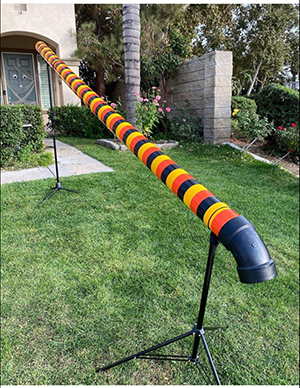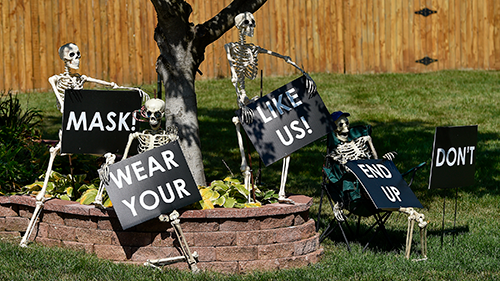Spooked by COVID-19? KCQ asks doctors and parents for tricks to keep Halloween safe
“What’s your KC Q” is a joint project of the Kansas City Public Library and The Kansas City Star. Readers submit questions, the public votes on which questions to answer, and our team of librarians and reporters dig deep to uncover the answers.
Have a question you want to ask? Submit it now »
by Lisa Gutierrez
Dr. Gabe Schifman is almost ready to hand out candy to the trick-or-treaters who come to his house on Saturday. But first he has to figure out how to send all that sugary goodness flying down 8 feet of PVC pipe.
That’s the great length he’s going to, all to keep kids a safe distance from his door.
Schifman’s homemade candy chute will eventually involve two ladders and lots of duct tape.
“What I don’t want to see is a group of 20 kids with no masks, all grouped on my stoop asking for candy all at the same time,” said Schifman, medical director of pediatric emergency medicine at Overland Park Regional Medical Center.
“On the flip side, ideally I would love a line of kids that are waiting for the chute, all masked up, all waiting their turn in the line, keeping social distance to get the candy, because everyone will get candy.”
When historians look back at Halloween 2020, there will surely be PVC pipe involved, one of the tricks that parents and neighbors are employing to keep the holiday from going down the toilet during the COVID-19 pandemic.
The question people have been asking for weeks now:
Is it safe for kids to go trick-or-treating this year? And if they come to your home, is it safe to give them candy?
“What’s your KCQ?,” a partnership with the Kansas City Public Library, is here to help.
The Centers for Disease Control and Prevention deemed trick-or-treating a “higher risk” activity because of COVID-19 — in effect counseling families (and anyone thinking of handing out candy) to avoid the tradition. Some Kansas City families plan to do that, leading to some difficult parent-child conversations.
But health officials say the risks can be minimized if families follow safety precautions, including social distancing and masks — the COVID-19 kind.
“There’s no simple answer to say is it safe or is it not safe,” said Schifman. “I think that the CDC is right to say that it has a possibility of being an event that could be hazardous. But you can do it safely if you’re going to do it.”

homemade candy chute, like this one created by a friend. | Gabe Schifman
Some parents are following safety advice from public health officials and physicians here and across the country to create pandemic-friendly activities.
Kids around Kansas City will be going to Halloween parties on Zoom. Neighborhoods are sponsoring Halloween car parades and scavenger hunts and inviting kids to search for candy hidden in yards, like Easter egg hunts — all designed to keep people socially distanced.
There are even new “treats” coming. “Instead of handing out candy, we hand out little bottles of hand sanitizers,” wrote one Twitter user who answered late-night host Jimmy Fallon’s call for #NewHalloweenTraditions. (Every child in America: No-oooooo.)
Someone else posted a video snippet showing how their homemade candy catapult will shoot Halloween candy toward trick-or-treaters, guaranteed to cause chills for every ER physician. Nothing quite says Halloween like a Butterfinger to the face.
It's All About the Risk
Local parents say they’re not sure how many trick-or-treaters to expect. Some neighborhoods planned activities during the day — it’s kiddie heaven to have Halloween fall on a Saturday — in case parents want to keep their children home and away from crowds in the evening.
One Overland Park neighborhood is throwing a trick-or-treat “alternative” Saturday afternoon, inviting residents to set up tables of treat bags in their driveways for the neighbor kids to take. Everyone has been told to wear a mask.
The CDC would call that a “moderate risk” activity. The federal health officials ranked traditional Halloween activities according to their level of risk.
Of lower risk: carving or decorating pumpkins with people in your own household, virtual costume contests, and a scavenger hunt where children look for a list of Halloween-themed items while they walk house-to-house in their neighborhood, “admiring Halloween decorations at a distance.”
Moderate risk activities include an open-air costume parade where people are distanced more than six feet apart, and a Halloween party outdoors where people wear masks and stay those six feet apart. Throwing an outdoor Halloween movie night with local family friends is moderately risky, too, and “if screaming will likely occur, greater distancing” is advised, the CDC says.
Attending a crowded costume party indoors made the list of higher-risk fun, alongside trick-or-treating.
The Kansas Department of Health and Environment recommends against trick-or-treating this year because “it is very difficult to maintain proper social distancing on porches and at front doors, ensure everyone (the kids and the folks handing out candy) are properly wearing face coverings, and because food sharing is risky.”
The Kansas City Health Department’s Halloween message is an equally blunt warning. “Scientific evidence clearly establishes that when groups of individuals gather together there is a higher risk of transmission of COVID-19,” the department’s website says.
There has been no widespread movement to ban trick-or-treating across the country, though the mayor of Springfield, Massachusetts, made headlines when he announced that door-to-door trick-or-treating would not be allowed, citing the difficulty of “social distancing on porches and at front doors.”
“Why in the hell would you want to put your child and/or yourself in harm’s way?” Mayor Domenic Sarno said during a news conference announcing the decision. “It makes no sense whatsoever.”
Cities, counties and states have instead offered cautions and safety tips.
“I think (health officials) are really hesitant to put a stop to our way of life. I understand that,” said Schifman. “But I also understand that if we really get a handle on this, and we do what’s best to reduce the spread and crush this virus, then we’ll be able to go back to normalcy sooner. So I think it’s tough.”

but parents are still going to let their kids make the rounds. Here, Kenneth Torres of Overland Park
made the point that people need to take COVID-19 precautions seriously. | JIll Toyoshiba/The Star
‘Some parents aren’t concerned’
It was a tough call for Northland mom Lauren Sieker to decide not to let her two children go trick-or-treating this year. With the holiday almost here, she’s still looking for that sweet spot, a safer alternative for her 10-year-old daughter, Maddie, and 4-year-old son, Jacob.
Sieker knows firsthand how destructive the virus is. Her grandfather died of COVID-19 in May.
She’s looking for an activity for her children in “something of a more controlled environment … where there’s upheld sanitation protocols and a little bit more awareness of social distancing than going to neighborhoods and random people’s houses.”
In the past, she’s taken them trick-or-treating inside her local Hy-Vee grocery store, where the kids got cookies in the bakery and a craft project. This year, the PTA at Maddie’s grade school in the Park Hill district is throwing a Halloween party on Zoom for students.
And on Saturday night, “we probably won’t give out candy, probably just going to do a sign on the door, whether we’re at an activity, or typically we’ll go visit my mom and maybe my aunt and uncle, so we’re kind of out and about.
“I’ve heard some parents aren’t concerned at all and they’re just going to continue as normal.”
Health officials don’t want parents to think of this year’s Halloween as normal. The pandemic calls for caution and safety principles everyone should know by now — good hand hygiene, wearing medical masks and social distancing.
“Going to get the candy … can certainly be done in a safer way than having parties or get-togethers indoors,” Dr. Dana Hawkinson, medical director of infection prevention and control for the University of Kansas Health System, has said.
Doctors are not keen on seeing packs of trick-or-treaters crowding sidewalks. If one comes toward you, said Schifman, move out of the way onto the grass.
“When you’re walking around with your child, you don’t want to go in a big clump or a big group of people as sometimes happens,” Dr. Angela Myers, director of the Division of Infectious Diseases at Children’s Mercy,, has cautioned. “It’s best to remember that we are doing our social distancing right now and try to keep doing that.”
Schifman said going trick-or-treating with just your immediate family, “or your small circle that you’ve kind of established during this pandemic,” can help reduce the risk of spreading something to people outside the group.
Parents having their kids use hand sanitizer after every house they visit is another way to reduce spread, he said.
Heading to the Lake
Telling her daughter and son, ages 9 and 11, that they aren’t going trick-or-treating this year was not a fun conversation for Overland Park mom Krista Votruba. But they know she’s been trying to keep them safe over the last few months.
“They were initially not very happy,” she said. “We’ve kind of been through a lot of stuff with this. Then I told them they could pick another virtual-school friend to spend the night here. But then, even their virtual-school friends seem to be going trick-or-treating in large groups, so we can’t even find one friend for each of them to stay at home.”
Votruba has an immune deficiency, and both she and her daughter have asthma, so they’re being “extra cautious” about their activities.
“For me, when I was thinking about Halloween it was, right off the bat, of course we’re not going to do it,” she said. “It seems we’re in the minority, but we’re still not doing it.”
She had considered having the family hang out in the basement Saturday night, but the thought of hearing the doorbell ring all night, even if the lights in the house were out, was too much.
So instead they’re heading to Table Rock Lake for the weekend, where the kids will hunt for king-size candy bars in the yard and party with their grandparents.
Even without a pandemic, Halloween spells risk for trick-or-treaters.
The nonprofit children’s safety organization Safe Kids Worldwide says twice as many children are killed by walking on Halloween than any other time of year. Safe Kids Kansas, along with Kansas Gov. Laura Kelly, issued Halloween safety tips on Tuesday.
Schifman said hospitals see twice as many child injuries at Halloween, “getting hit by cars, tripping and falling, spraining ankles and wrists, breaking arms, breaking legs and lacerations. Those things go through the roof on that night.
“Even without COVID, Halloween by nature does carry its own risk with all the kids out and about.”
Submit a Question
Do you want to ask a question for a future voting round? Kansas City Star reporters and Kansas City Public Library researchers will investigate the question and explain how we got the answer. Enter it below to get started.


